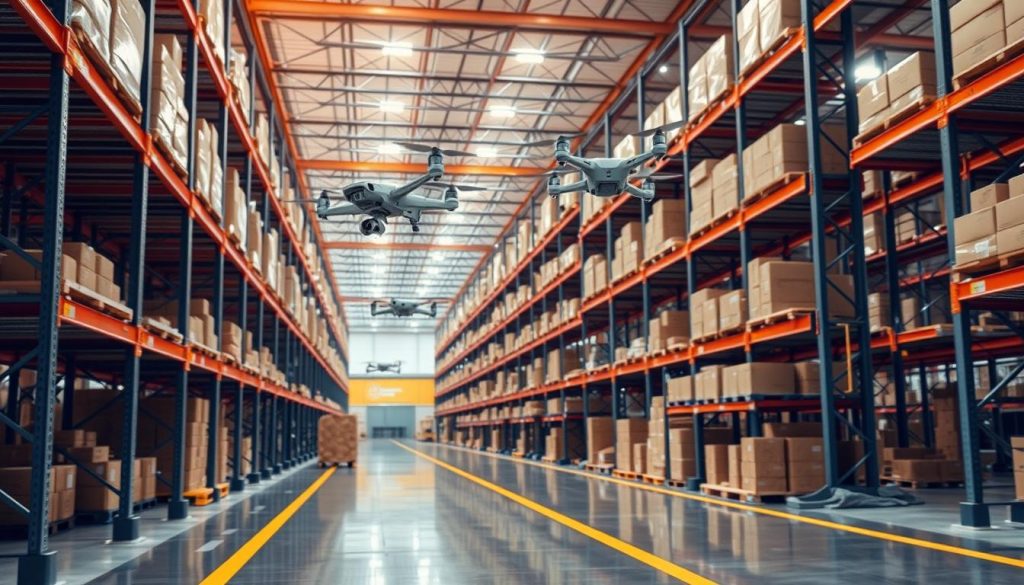What if the future of logistics is closer than we think? Supply chain dynamics are changing quickly. Embracing modernisation in logistics is crucial. By improving supply chains, products move smoothly from where they are made to the final users. The Chartered Institute of Logistics and Transport shows how new practices are essential to meet customer needs. Logistics Management studies reveal companies save money and work more efficiently with new supply chain innovations.
The World Economic Forum states innovative logistics are key for global trade competitiveness. Let’s explore how new technologies and methods are changing the logistics world.
The Role of Technology in Modern Logistics
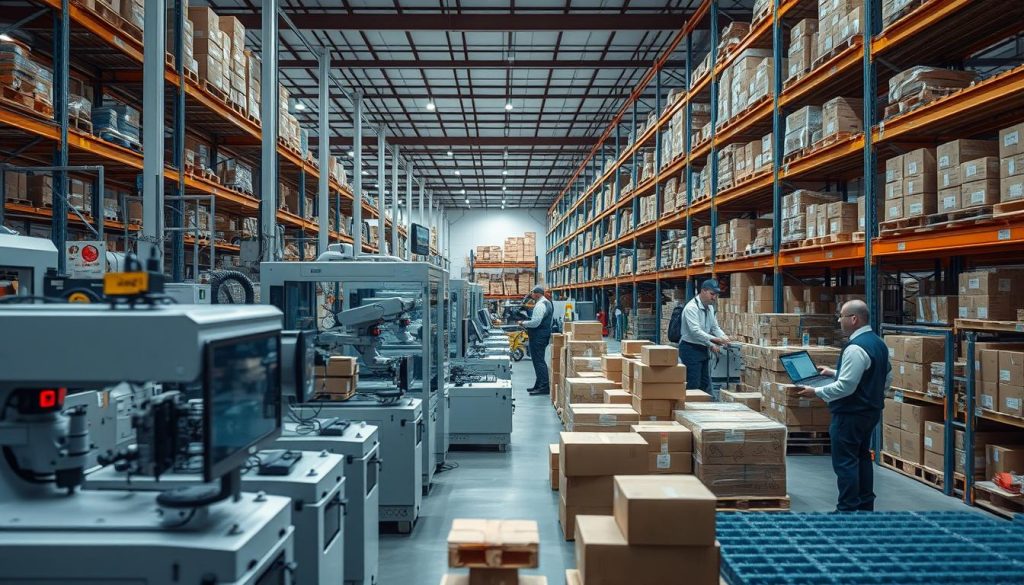
Technology is key to changing the world of logistics today. It helps companies become more efficient and transparent. Let’s explore how new technologies are reshaping logistics.
Implementation of AI and Machine Learning
AI in logistics makes things run smoother. It uses special algorithms to predict demand. This cuts costs and reduces waste. AI helps vehicles choose the best routes, saving fuel and cutting transport costs.
A report by the International Data Corporation shows big spending on AI for logistics. It can make customer service and company operations better.
Blockchain for Transparency and Security
Blockchain is making supply chains more secure and clear. It creates a record that can’t be changed. Everyone involved can see where goods are at all times. This reduces fake goods, makes sure shipments are correct, and builds trust.
A Forbes report found blockchain helps keep track of shipments. It makes sure the quality of goods stays high from start to finish.
The Rise of Automation
More and more, supply chains use automation. Drones, self-driving vehicles, and robots are common now. They’re often seen in warehouses and delivery, speeding up work and reducing mistakes.
The Journal of Commerce noted that automation improves productivity. It happens in ports and distribution centres. This creates a better logistics system for everyone.
Benefits of Supply Chain Innovation
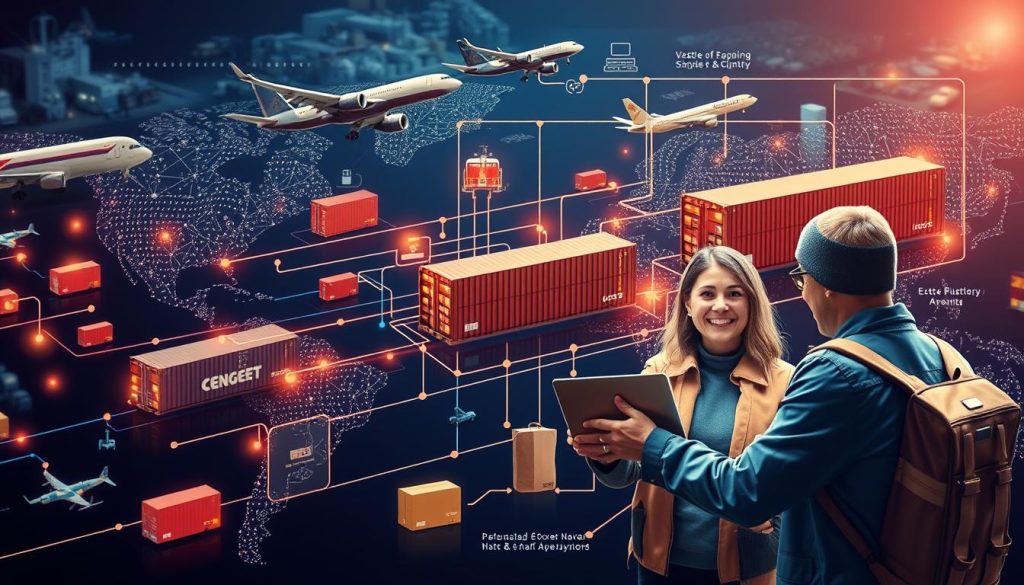
Innovations in the supply chain give companies an edge by shortening lead times. They adapt quicker to market changes. This quick response to customer needs is crucial for staying on top.
Technology boosts efficiency in businesses. It leads to big cost savings and smarter use of resources. Automated processes make operations smoother, freeing up time to focus on main activities.
Being accurate and open in supply chains helps win customer trust. If customers see what’s happening, they feel confident about the supply chain’s reliability. This makes them more loyal. A PwC report links supply chain innovation with higher profits, showing financial rewards from new practices.
The Harvard Business Review explains that supply chain innovation lets companies quickly meet consumer needs. They get ahead of rivals. This adaptability improves market reaction and makes a business more flexible.
Bain & Company’s customer surveys show a tight bond between supply chain openness and customer loyalty. More transparency means customers feel safer. This directly boosts their satisfaction and loyalty to the brand.
Challenges in Traditional Supply Chains

Traditional logistics challenges are a big problem for supply chains. They cause inefficiencies and delays that slow productivity. Businesses often deal with old processes and a lack of quick information. This makes supply chain problems worse and slows down market responses.
Inefficiencies and Delays
Supply chain bottlenecks come from many inefficiencies. One major issue is using old systems and manual data management. McKinsey & Company analysed this situation. They found that sticking to old systems makes supply chains less flexible, causing delays. These delays then harm overall performance and customer happiness.
High Operational Costs
Traditional supply chains also face high operational costs. Wrong inventory management, poor route planning, and manual tasks increase these costs. The Financial Times points out that rising costs make these challenges worse. This is especially true in places with hard customs processes. According to data from the Logistics Bureau, companies with outdated supply chains get more customer complaints and lose sales. This shows how vital cost reduction strategies are.
Strategies to Overcome Supply Chain Challenges
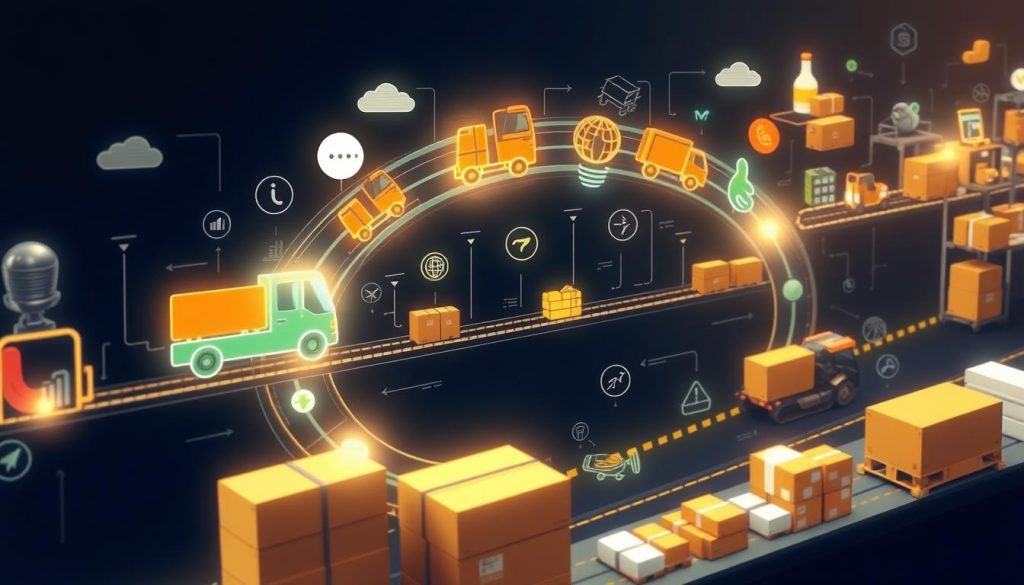
Today’s business world is fast-paced. Overcoming supply chain challenges needs a careful plan. By using lean management and improving communication, companies can boost their supply chain. This approach helps things run smoothly, cuts waste, and makes the system quicker to respond.
Adopting Lean Management Practices
Using lean management is key for a better supply chain. Toyota’s story shows cutting unnecessary production saves money on stock. Lean management cuts waste and uses resources well, making the supply chain more efficient.
Streamlining Communication Channels
Good communication in logistics is crucial. Research by the American Society of Transportation and Logistics shows integrated communication helps with global supply chain challenges. Deloitte suggests solid communication plans are needed to lower risks and make logistics run without issues.
By improving supply chain processes and communication, businesses can enhance their operations. This keeps them ahead in the competitive market.
The Impact of E-commerce on Logistics
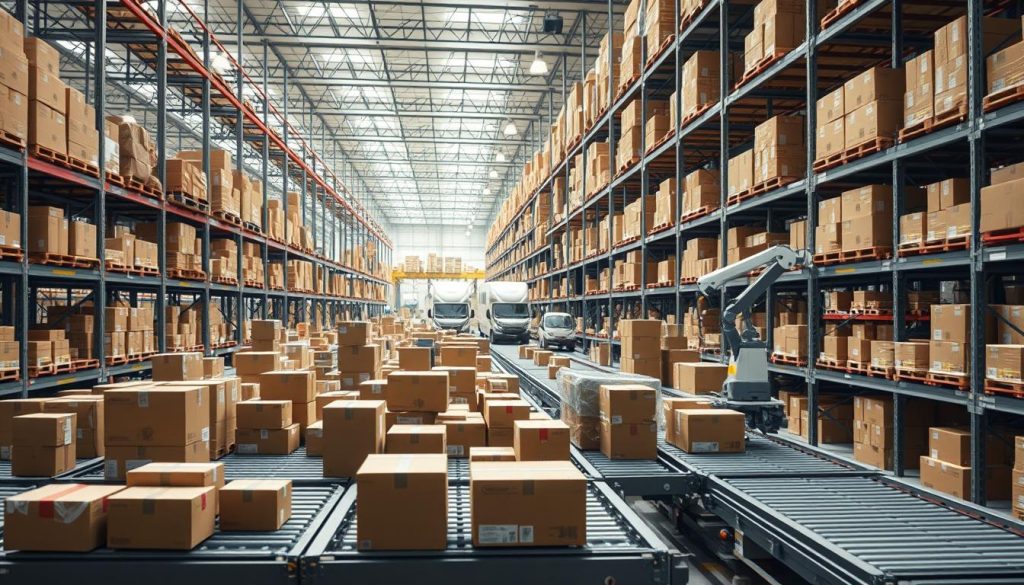
The rise of e-commerce has greatly changed the logistics industry. It has made the need for logistics demands for fast and dependable delivery services go up. This growth has led to a digital supply chain transformation.
This change touches everything from storage to the delivery of products to customers’ doors.
Statista’s forecasts show that e-commerce growth will keep pushing logistics needs to evolve. The Centre for Retail Research backs this up. It says online shopping’s growing orders put a lot of pressure on logistics networks.
Big players like Amazon and Alibaba show how digital supply chain transformation meets logistics demands. They use new ways to efficiently handle their growing e-commerce needs.
Optimising Inventory Management
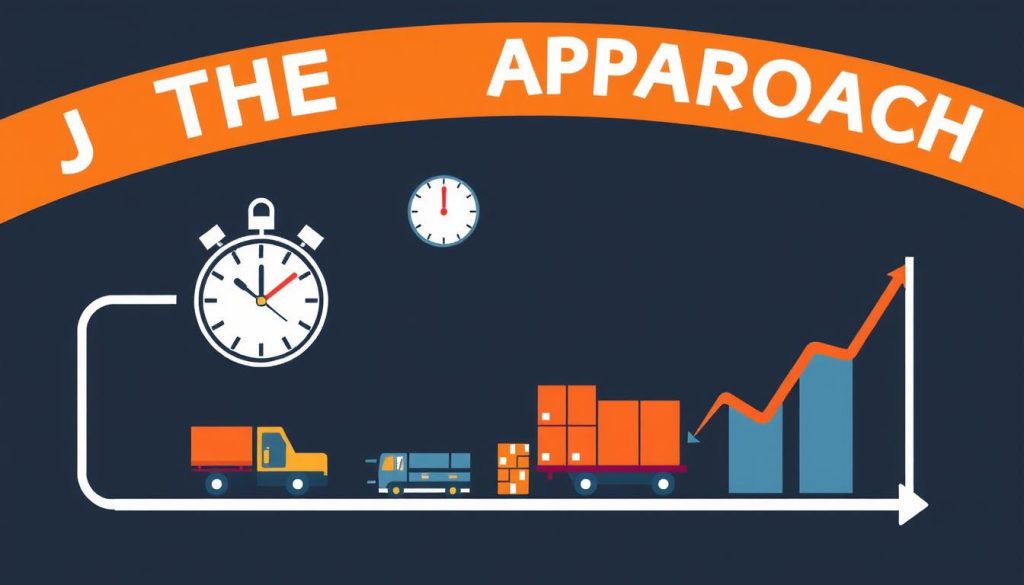
In today’s fast-paced business world, managing inventory well is key to staying ahead. Firms are using new ways and tech to get better at handling stock.
Just-in-Time Inventory
The Just-in-Time (JIT) method is changing how companies manage inventory. By getting goods only when needed for production, firms cut waste and save on storage. The Journal of Inventory Management says JIT helps industries a lot, making stock control much better.
Real-Time Inventory Tracking
Thanks to new tech, companies can now track stock levels accurately and instantly. This reduces the chance of having too much or too little stock, affecting sales and costs. IBM’s report shows how connecting inventory systems to IoT devices keeps stock levels just right. A report by KPMG notes real-time info improves how firms buy goods and manage stock. This means happier customers due to more efficient stock control.
With the adoption of these new techniques, inventory management is set to improve even more. Tech will be crucial in making stock handling better and more effective.
Sustainable Practices in Logistics

In modern logistics, sustainability is key. By going green, companies help the planet and improve efficiency. They play a big role in cutting carbon emissions.
Green Transportation Options
Using green transport is a top way to make supply chains eco-friendly. Electric vehicles and biofuels cut down emissions a lot. More and more businesses are doing this to be sustainable. The European Environmental Agency says this helps the planet and saves money in the long run.
Reducing Carbon Footprint
Cutting carbon in supply chains needs several approaches. It involves energy-saving warehouses, smarter routing, and using green energy. The Carbon Trust offers detailed advice on reducing carbon emissions. Companies like Unilever have greatly lowered their emissions using these methods.
By adopting green practices, companies do better and help the environment. This makes the world a better place for the next generation.
The Future of Logistics in the United Kingdom

The future of logistics in the United Kingdom is changing fast. This is because of new technology and changes after Brexit. These adjustments affect how goods move and are managed.
Dealing with post-Brexit supply chain issues means the UK has to sort out new customs rules and trade deals. A report by Logistics UK talks about these challenges. It says that UK logistics will change to overcome them.
Adopting new ways in logistics means using the latest tech. The government plans to put money into new technologies for the sector. This move aims to keep the UK ahead in global competition by making things more efficient.
The use of technology in logistics is set to grow, according to the Freight Transport Association. They believe automation, AI, and data analytics will make a big difference. These advances should make operations smoother, cut costs, and improve services.
In summary, UK logistics is at a turning point. It’s trying to deal with Brexit while also bringing in new tech. Keeping up with these changes will help the industry face future hurdles successfully.
Case Studies: Successful Supply Chain Innovations

Real-world examples show how new tech changes supply chains. Looking at blockchain case studies, we see big changes. AI in inventory management teaches companies lots of lessons from these successes.
Company A: Utilising Blockchain
Company A used blockchain to make their supply chain better. IBM’s Blockchain Platform says it made verification quicker and reduced fraud risks. These efforts have led to more trust and lower costs in their operations.
Company B: Implementing AI for Forecasting
Company B improved its supply chain by using AI for better demand forecasts. MIT Technology Review shows how this made stock management smarter and cut unnecessary stock. This AI use made them more efficient and helped them make better decisions.
Gartner’s reports show AI and blockchain are really changing the supply chain world. These stories prove how much advanced technologies can do.
Impact of Brexit on UK Supply Chains
Brexit has brought big changes to UK supply chains. These include more customs paperwork and possible trade barriers. Companies now need to think carefully about how they move goods.
A study by the Chartered Institute of Procurement & Supply shows challenges for UK logistics providers. Many had to change their plans quickly. They are stockpiling goods, finding new suppliers, and using different transport routes.
The British International Freight Association helps companies with new customs rules. Their advice is key for businesses that trade across borders. It helps them deal with trade barriers better.
The UK Trade Policy Observatory looked at long-term effects on supply chains. They think companies will bring manufacturing back to the UK. This would reduce dependence on foreign suppliers and protect them from disruptions.
- Enhanced customs procedures increasing operational costs
- Stockpiling as a short-term solution to mitigate supply chain disruptions
- Diversification of supplier bases to balance risks
- Exploring alternative transport routes to maintain efficiency
Businesses need to adapt to stay ahead. With good planning, they can handle Brexit logistics challenges. This ensures smoother operations in a changing economy.
The Importance of Data Analytics in Logistics
Data analytics is now crucial in the logistics industry, helping to boost efficiency. By using big data, companies can decide how to make their supply chains smoother. It helps predict needs better and improves decision-making.
Predictive Analytics for Demand Forecasting
Predictive models in supply chains help firms guess what customers will want next. They look at past data and trends to see future demand. This means they can manage what they stock more wisely, avoiding too much or too little. McKinsey & Company say such analytics notably enhance supply chain work. They let businesses spot trends early.
Improving Decision Making
Data-led logistics give managers the insights they need to make smart choices. The Massachusetts Institute of Technology (MIT) Centre for Transportation & Logistics says this makes supply chains clearer and quicker to react. SAS reports agree, showing how predictive analytics helps with making better, faster logistics decisions. This lets firms quickly adjust to changes in the market or what customers want.
The Role of Logistics Service Providers
Logistics service providers (LSPs) are crucial in today’s competitive market. They help businesses by offering specialised knowledge and technology. This means companies don’t have to spend a lot on getting these benefits. Working with LSPs can improve supply chains, cut costs, and make customers happier.
More businesses are turning to third-party logistics (3PL) providers, a trend highlighted by Armstrong & Associates. This growth shows the clear benefits of outsourcing logistics, like better supply chain flexibility. 3PL services do more than just move goods; they also handle returns and add value, offering wide-ranging solutions for different needs.
A survey by Inbound Logistics found many benefits to outsourcing logistics. Businesses saw decreases in costs, better delivery performance, and happier customers. These are key for staying ahead of competitors.
Case studies from top logistics firms such as DHL showcase the power of LSPs. They provide strategies that meet the specific needs of various industries. These success stories confirm that using third-party logistics goes beyond following a trend. It’s a smart approach for businesses to tackle complex logistics issues effectively.
Leveraging IoT in Supply Chain Management
IoT is changing how we manage supply chains by allowing for the tracking of assets in real-time and making fleet management more efficient. This technology makes it easier to see where assets are at any moment. It also makes logistics processes better, saving money and boosting the efficiency of the supply chain.
Enhancing Asset Tracking
IoT devices attached to containers, products, and vehicles enable monitoring at all times throughout the supply chain. The International Journal of Production Research found that using IoT increases how well we can track assets. Gaining real-time data helps us know where our assets are, their condition, and how they are moving. This ensures improved management and decision-making.
Improving Fleet Management
IoT also greatly improves how we manage fleets. It helps with maintaining vehicles before issues arise, planning better routes, and lessening the time vehicles are not in use. The Technology & Maintenance Council reported that IoT boosts how long vehicles can be used and makes it easier to plan maintenance. According to Cisco, IoT is changing fleet management for the better, leading to cost reductions and more efficient operations.
To sum up, implementing IoT in logistics for real-time monitoring and better fleet management makes supply chains run smoother. This brings big benefits and adds value to logistics tasks.
Ensuring Supply Chain Resilience
Today’s global market is complex and unpredictable. Ensuring supply chain resilience is now a critical goal. This kind of planning helps businesses stay strong during tough times.
Building Redundancies
Adding backups like extra suppliers and flexible manufacturing setups is key. It helps keep businesses running smoothly when unexpected events happen. This approach creates strong supply systems ready for change.
Risk Management Strategies
A good risk strategy for the supply chain involves several steps. First, identify what might go wrong. Then, figure out how bad it could be and plan for it. Research from the Institute for Supply Management shows how vital this is worldwide.
The Business Continuity Institute’s report highlights the importance of being prepared. It talks about what makes a supply system strong. The Resilience360 Annual Risk Report shows through examples how being proactive helps deal with problems.
Adopting a Customer-Centric Approach
Today’s market is very competitive. Adopting a customer-centric approach in logistics is essential. Companies can improve satisfaction and loyalty by focusing on customer needs. This involves personalised delivery options, constant updates, and flexible services.
Providing flexible delivery options is a major perk of supply chain personalisation. It lets customers choose when they receive their items, like same-day delivery. Updates about shipping status and delays also help build trust.
Excelling in customer service leads to more repeat business and better brand reputation. According to the Customer Service Institute, a customer-centric supply chain strengthens long-term relationships. Forbes also points out personalisation as a market differentiator.
Customer satisfaction is closely linked to the quality of logistics, says the American Customer Satisfaction Index. Focusing on customer needs drives growth and success. Companies focused on service excellence will stay ahead by keeping customers loyal.
Customs and Regulatory Compliance in Logistics
Ensuring you follow customs rules in logistics is vital to keep your international supply chain running smoothly. It helps you avoid losing money through fines or experiencing delays in shipping. Knowing and following the rules of international trade and local laws is essential for perfect logistics operations.
Navigating International Trade Laws
It’s critical to understand tariffs, trade agreements, and rules on imports and exports. The World Customs Organization provides guidance to businesses. They help them comply with customs rules in global trade. The International Chamber of Commerce keeps businesses informed on changes to trade laws affecting logistics.
Compliance with Local Regulations
Following local and regional rules can be different depending on where you are. Logistics providers must know about these varying rules. Thompson Reuters has detailed studies showing the different compliance requirements. Being ahead in following these regulations prevents hold-ups and makes sure logistics run smoothly.
Harnessing the Power of Big Data
In today’s fast-changing logistics world, using big data in supply chain management is essential. It helps businesses stay ahead. By looking at large amounts of logistics data, companies can find patterns. This leads to better decision-making.
Data-Driven Decision Making
Using a data-driven approach improves supply chain activities. Companies can better plan routes, manage inventory, and set delivery schedules. Harvard Business School shows that big data boosts operational efficiency. It gives insights that help make smarter choices.
Optimising Logistics Operations
Logistics data analytics are key to making operations more efficient. BCG’s report includes case studies showing how big data enhances performance. It makes processes smoother and cuts costs. Using big data ensures supply chain strategies can adapt to changes in the market.
How to Implement Supply Chain Innovation Successfully
To implement supply chain innovation, you need a careful plan. The first step is understanding your current operations and how they can improve. It is vital to get all stakeholders on board to ensure they support the changes. An adaptable infrastructure also helps in adding new technologies smoothly.
Building a culture focused on continuous improvement is key. By training employees, you make sure they can handle new methods in logistics. This creates an environment where everyone is ready to use new systems efficiently. McKinsey & Company state that a strong organisational culture and capabilities are essential for successful change.
It is important to keep an eye on how things are going. By getting feedback from different levels of operation, you can make small, impactful changes. This way, you ensure your innovation strategy works well and lasts. The Project Management Institute suggests using structured project management approaches to manage changes well.
Examining case studies from the Association for Supply Chain Management gives further insight. These examples show how top companies have made successful changes and the benefits they gained. Therefore, improving distribution strategies involves careful planning, preparing your team, and always being ready to adjust to keep up with the market.

